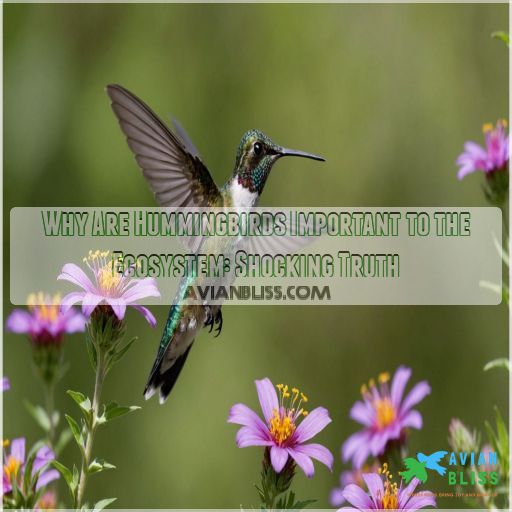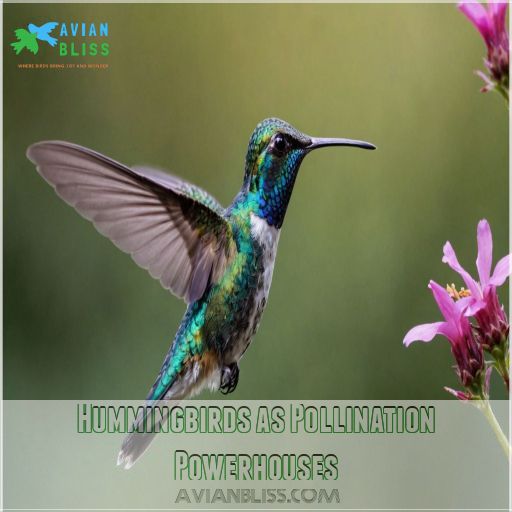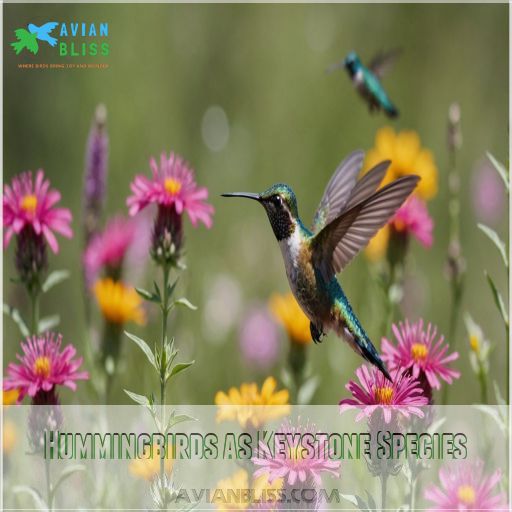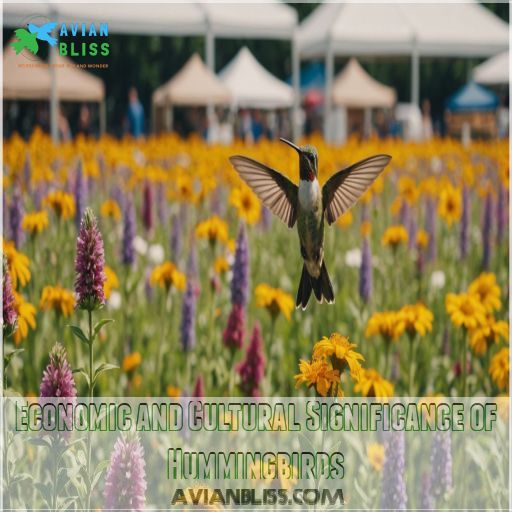This site is supported by our readers. We may earn a commission, at no cost to you, if you purchase through links.

These tiny powerhouses zip around sipping nectar like it’s their superpower, helping plants do their whole reproduction dance. With beaks custom-built for precision pollination, hummingbirds spread pollen and seeds, keeping plant life diverse and thriving.
They also play a part in pest control, keeping insect populations in check. By maintaining the balance in food chains and landscapes, they act as tiny matchmakers and ecosystem guardians.
Each wing beat contributes to a world of vibrant life.
Curious about their cultural significance? There’s a whole lot more to this hummingbird buzz!
Table Of Contents
- Key Takeaways
- Hummingbirds as Pollination Powerhouses
- Ecological Balance and Hummingbirds
- Hummingbirds and Ecosystem Interconnectedness
- Hummingbirds as Keystone Species
- Economic and Cultural Significance of Hummingbirds
- Conservation Efforts and Hummingbird Preservation
- Frequently Asked Questions (FAQs)
- Why are hummingbirds important?
- Why are hummingbirds adapted to pollination?
- How do hummingbirds affect the environment?
- Why do hummingbirds need a diverse ecosystem?
- What would happen if hummingbirds went extinct?
- What would happen to the ecosystem without hummingbirds?
- What do hummingbirds do to help the environment?
- Why is a hummingbird a keystone species?
- How do hummingbirds survive during winter months?
- What role do hummingbirds play in migration patterns?
- How does their diet affect insect populations?
- Can hummingbirds adapt to urban environments?
- What are the nesting habits of hummingbirds?
- Conclusion
Key Takeaways
- Hummingbirds are nature’s multitaskers, zipping around as pollinators and keeping plant life thriving. Imagine them as tiny matchmakers flying from bloom to bloom, spreading pollen and ensuring that gardens stay vibrant and diverse.
- Beyond flowers, these feathered acrobats help control pest populations by feasting on insects, making them natural pest controllers. Think of them as the ecosystem’s understated heroes, quietly balancing the food chain.
- As they migrate, hummingbirds connect far-flung ecosystems, helping spread genetic diversity. Picture them sprinkling life like nature’s confetti, boosting biodiversity across the map.
- Hummingbirds aren’t just vital for the ecosystem—they’re also cultural icons, driving ecotourism and symbolizing strength and transformation in various cultures. They’re more than just a pretty face in the garden!
Hummingbirds as Pollination Powerhouses
When you picture hummingbirds, think of them as the tiny superheroes of the plant world, zipping around with their spiky beaks designed for sipping nectar.
Their daily commute from flower to flower makes them essential to the pollination process, ensuring a vibrant and diverse garden for everyone to enjoy. They are truly the tiny superheroes of the plant world.
Specialized Nectarivores and Pollination
Picture a hummingbird’s beak like a custom straw, perfectly designed for sipping nectar from specific flowers.
This unique beak diversity helps with efficient pollination as these specialized nectarivores flit from bloom to bloom.
Along the way, pollen hitches a ride, boosting seed dispersal and plant species diversity.
Your hummingbird garden helps prevent habitat destruction and supports these ecological interactions.
Co-evolution With Plants for Efficient Pollination
In the enchanting dance of nature, hummingbirds and plants have co-evolved, making hummingbird-plant relationships a marvel of efficiency.
These birds’ specialized beaks allow access to nectar deep inside flowers, driving floral adaptations that enhance pollination efficiency and plant diversity.
So, next time you explore national parks, appreciate these tiny powerhouses shaping ecosystems amidst climate change, not just sipping sugar syrup.
Transporting Seeds and Pollen Between Flowers
One might say hummingbirds are nature’s couriers, zipping between flowers with grace. They boost pollination efficiency by carrying pollen like secret agents.
- Seed dispersal: Not seeds, but spreading genetic materials.
- Plant diversity: They help a mix of species thrive.
- Co-evolution: Their beaks evolve with the plants they pollinate.
Importance in Plant Reproduction and Diversity
Imagine a world where hummingbirds are nature’s tiny matchmakers, flitting from bloom to bloom, enhancing plant diversity through efficient pollination as they consume nearly half their body weight in nectar, visiting hundreds of flowers
.
Your garden’s vibrant reds and yellows owe them gratitude. By carrying pollen on their beaks, they support countless species, creating a ripple effect of life.
This mutualistic ballet highlights their important role, urging us to think about conservation efforts seriously.
Ecological Balance and Hummingbirds
You might be surprised to learn that hummingbirds play a significant role in maintaining the delicate balance of ecosystems.
These tiny birds are natural pest controllers, helping to regulate insect populations.
They’re also important seed dispersers, contributing to the spread and diversity of plant life.
Role in Maintaining Healthy Ecosystems
Hummingbirds, beyond their pollination prowess, maintain ecosystem balance by impacting food chains and habitats. Their role is like nature’s tiny acrobat, both entertaining and important in their dedication to raising a family
.
Consider these impacts:
- Pollination: Spurring plant diversity.
- Food Chain: Essential prey and predator balance.
- Habitat Influence: Shaping landscapes.
- Keystone Species: Holding ecosystems together.
They’re nature’s charming multitaskers!
Natural Pest Controllers and Population Regulation
You can’t help but appreciate hummingbirds’ knack for maintaining balance in ecosystems.
Their diet includes not just nectar, but also a whopping 2,000 tiny insects daily, making them superb insect predators.
With their help, pest populations stay in check, showcasing impressive pest control benefits and contributing to overall population balance and ecosystem impact.
Seed Dispersers and Plant Colonization
Consider the remarkable role of hummingbirds in seed dispersal and plant colonization.
These tiny aerial acrobats transport seeds across fragmented habitats, boosting plant diversity and helping ecosystems bounce back from disturbances.
Climate change impacts aside, their contributions help maintain ecological balance.
As they zip between blooms during hummingbird migration, they enhance genetic diversity, sprinkling life like nature’s own confetti , showcasing ecological balance.
Impact on Food Chains and Biodiversity
Just as seeds spread by hummingbirds foster plant diversity, their role in food chains boosts biodiversity.
Imagine their role in influencing ecological balance.
- Hummingbird Predators: Hawks, owls, and even fish balance populations.
- Ecosystem Services: They pollinate, impacting plant growth.
- Species Extinction: Their absence could trigger a domino effect in ecosystems.
Hummingbirds and Ecosystem Interconnectedness
You mightn’t think much about those tiny hummingbirds flitting around, but they’re like the ecosystem’s backstage crew, keeping everything running smoothly.
When hummingbirds vanish, it’s like pulling a thread from a sweater—suddenly, your garden, and even the planet, might start coming undone.
Interdependency With Plants and Other Species
Ever watched a hummingbird flitting flower to flower, engrossed in its nectar hunt?
This spectacle showcases mutualism, where their sleek bills co-evolved with tubular blooms, setting off a delightful dance of pollination.
Hummingbirds are feathered keystones in the food chain, fostering ecosystem balance.
They carry pollen, sparking plant diversity, amid climate challenges (Source).
Importance in Maintaining Ecosystem Balance
You may not realize it, but hummingbirds play a key role in maintaining the delicate balance of our ecosystems.
As specialized pollinators, they:
- Facilitate the reproduction of countless plant species
- Regulate insect populations by feeding on them
- Disperse seeds, enabling plant colonization
- Serve as a barometer for environmental changes
Their interconnectedness with the natural world is truly remarkable.
Effects of Hummingbird Loss on Ecosystem Health
When hummingbirds vanish, the ecosystem feels a domino effect.
Imagine this: with fewer polls buzzing from flower to flower, plant diversity declines, setting off food web disruptions.
Bugs like mosquitoes thrive without their natural pest controllers, leading to insect population rise.
The whole show runs the risk of ecosystem stability loss, highlighting hummingbirds’ irreplaceable roles.
Hummingbirds as Indicators of Climate Change
If you’ve ever marveled at hummingbirds flitting by, you’ve seen climate change indicators in action.
Their migration patterns and changing flowering times reveal shifts in ecosystems.
Habitat loss and population decline further highlight these challenges.
Conservation strategies, like planting native flowers, help.
These vibrant birds aren’t just pretty faces—they’re key climate messengers (Source).
They are an important part of the environment, and their well-being is closely tied to the health of ecosystems, making them a key climate messengers.
Hummingbirds as Keystone Species
You might think of hummingbirds as tiny jewels flitting around your garden, but they’re actually keystone species essential for ecosystem stability.
Without these nectar-loving daredevils, plant life could suffer, leading to a cascading effect that’s no laughing matter for other species relying on those plants.
Definition and Characteristics of Keystone Species
Picture a puzzle missing a key piece—that’s what happens when a keystone species vanishes.
Hummingbirds exemplify keystone species roles by maintaining ecosystem stability through species interactions.
They connect various plants via pollination, preventing trophic cascades that disrupt ecosystems.
Every hum of their wings supports diverse life, orchestrating a complex dance in nature’s grand play.
Hummingbirds as Exemplary Keystone Species
Think of hummingbirds as nature’s pint-sized superheroes.
They’re keystone species, which means their role in pollination is critical for diverse plant species, helping the ecosystem flourish.
Without them, you’d face a domino effect of decline, habitat loss, and food web impact.
Celebrate conservation successes and appreciate these feathery dynamos for their important dance of co-evolution.
Importance in Maintaining Ecosystem Structure
Ever wonder what keeps ecosystems ticking like a well-oiled machine? Hummingbirds!
Their role as keystone species helps:
- Food web impact: They pollinate plants important to many creatures.
- Habitat diversity: They maintain diverse plant life.
- Ecosystem balance: Their activities regulate species populations.
- Species interdependence: They connect plants and animals, fostering interdependence.
Impact of Hummingbird Loss on Ecosystem Function
Lose the hummingbirds, and you might as well say goodbye to a thriving ecosystem.
These tiny pollinators are the glue that holds everything together – from plant communities to food webs.
Without them, you’d see a cascade of disruptions, from insect population booms to declining seed dispersal.
It’s a recipe for ecosystem instability.
Economic and Cultural Significance of Hummingbirds
You might be surprised that hummingbirds aren’t just fun to watch; they actually boost economies through ecotourism.
They’re symbols in art and folklore, reminding you that these tiny creatures carry big cultural significance, which makes them more than just fun to watch; they have big cultural significance.
Ecotourism and Hummingbird-related Economic Benefits
Hummingbird ecotourism brings a flutter of economic benefits. Join hummingbird-watching tours, and you’ll find a thriving birdwatching economy.
Eco-lodges pop up like mushrooms after rain, and conservation funding makes sure these tiny jewels continue to dazzle.
- Hummingbird-Watching Tours: Discover rare species.
- Birdwatching Economies: Boost local businesses.
- Eco-lodges & Conservation: Support sustainable travel.
These ventures make nature tourism an economic powerhouse.
Cultural Importance and Symbolism of Hummingbirds
How do hummingbirds flutter their way into our hearts and cultures?
In Aztec mythology, they’re symbols of strength and transformation, while Indigenous peoples see them as messengers of joy and healing .
Their vibrant energy inspires cultural representations and spiritual significance, teaching us that small creatures can make a big impact on life’s colorful tapestry .
Hummingbirds in Art, Literature, and Folklore
In the tapestry of human expression, you’ll find hummingbirds fluttering gracefully. They’re more than just pretty feathers. Did you know they symbolize deep truths and stories?
Here’s a peek:
- In folklore origins, they’re seen as messengers from the heavens.
- Literary references depict their agility.
- Artistic depictions capture their vibrant beauty.
Hummingbirds as National Symbols and Emblems
Imagine a tiny bird with such charisma, it’s a national treasure in Jamaica—meet the Doctor Bird, the national bird with a historical twist.
Its iridescent feathers and cultural significance in folklore and song make it a symbol of agility and energy.
So, if Jamaica had a feathered mascot, this colorful character would definitely steal the spotlight with its charisma.
Conservation Efforts and Hummingbird Preservation
You might think these tiny, energetic birds can fend for themselves, but hummingbirds face serious threats like habitat loss and climate change.
By getting involved in conservation efforts and spreading the word about their importance, you can help keep these little pollinators buzzing around for generations to come.
Threats to Hummingbird Populations and Habitats
Despite their widespread appeal, hummingbirds face several threats.
Habitat loss, climate change, invasive species, and pesticide use are among the biggest dangers.
To help these tiny pollinators, you can:
- Grow native plants that attract hummingbirds, like glorious hanging blooms
.
- Avoid using pesticides in your garden.
- Support conservation organizations working to protect hummingbird habitats.
- Participate in citizen science projects to track hummingbird populations.
Conservation Strategies and Organizations
Every hummingbird deserves a cozy spot at hummingbird sanctuaries, where habitat restoration thrives.
By offering conservation funding and embracing citizen science, you’re helping these tiny wonders.
Organizations coordinate to protect nectar landscapes and spur community involvement.
Remember, even a single act can ripple through ecosystems like a pebble in a pond.
Join efforts to preserve these enchanting creatures, where conservation funding can make a difference.
Importance of Public Awareness and Education
With hummingbird conservation strategies in place, understanding through public awareness and education becomes the next leap.
You can engage with educational programs, participate in citizen science, and protect habitats.
Funny how even a little knowledge can make you feel like a superhero!
Let’s keep these tiny pollinators flying by spreading awareness and nurturing curiosity .
Community Involvement in Hummingbird Preservation
You can make a difference in hummingbird preservation! Public awareness plays a key role, but real magic happens when communities get involved.
Consider these:
- Hummingbird gardens in your yard.
- Citizen science projects for data collection.
- Habitat restoration activities.
- Education programs and volunteer opportunities.
Each action, like planting a tree, contributes to the bigger picture.
Frequently Asked Questions (FAQs)
Why are hummingbirds important?
Hummingbirds play a key role as pollinators, especially for plants that rely on them due to their specialized beaks and hovering flight.
This unique relationship helps maintain biodiversity and stabilizes ecosystems, showcasing their mighty impact (Source).
Why are hummingbirds adapted to pollination?
Hummingbirds’ long, slender bills and tube-like tongues are perfectly adapted to drink nectar from brightly-colored flowers, which they pollinate as they flit from bloom to bloom.
How do hummingbirds affect the environment?
Colorful creatures, hummingbirds help habitats by pollinating specific plants and preventing plant population problems.
Their precise preferences push plants to adapt, ensuring diverse ecosystems flourish.
Plus, their playful personalities add a touch of magic to any garden.
Why do hummingbirds need a diverse ecosystem?
You can’t underestimate the role of a diverse ecosystem for hummingbirds.
They rely on a variety of plants for food and habitats, which helps them thrive and continue their essential job of pollination.
What would happen if hummingbirds went extinct?
Almost 350 types of hummingbirds could vanish, triggering a domino effect.
Without them, many plants might struggle to survive, as these tiny birds are key pollinators.
Losing hummingbirds would upset delicate ecological balances, impacting other species too.
What would happen to the ecosystem without hummingbirds?
Without hummingbirds, key flowering plants may struggle to reproduce, leading to reduced plant diversity.
This disruption could cascade through the ecosystem, affecting other species that depend on these plants for food and shelter, ultimately affecting the entire ecosystem.
What do hummingbirds do to help the environment?
Picture tiny superheroes darting through gardens, hummingbirds pollinate flowers, ensuring plant reproduction and biodiversity thanks to their attraction to red nectar sources red nectar signals
.
They play matchmaker for flowers, promoting genetic diversity and enabling ecosystems to thrive.
Their tiny wings stir up life, proving nature’s interconnectedness.
Why is a hummingbird a keystone species?
Hummingbirds are keystone species because they pollinate various plants, ensuring ecosystem diversity.
Their unique method lets them visit thousands of flowers daily, playing a crucial role much like bees, and supporting numerous species’ survival and reproduction.
How do hummingbirds survive during winter months?
You’ll be blown away by how these tiny titans survive winter!
They either migrate thousands of miles or hunker down, slowing their metabolism to conserve energy.
Backyard feeders are a lifeline for overwintering hummingbirds.
What role do hummingbirds play in migration patterns?
Watching hummingbirds zip across continents, you’d see their key role in migration patterns.
These tiny travelers track blooming flowers, ensuring pollination miles apart.
Their flights are all about finding blooming stops and dodging habitat loss challenges.
How does their diet affect insect populations?
Their diet, rich in insects like mosquitoes and spiders, impacts these populations by keeping them in check.
Hummingbirds consume a significant number of bugs, promoting balance in ecosystems and assisting in the transfer of energy from plants.
Can hummingbirds adapt to urban environments?
Imagine you’re exploring the garden and spot a hummingbird adapting to the city buzz.
These agile birds exploit urban resources like feeders, showing they’re not just surviving but thriving amidst noise and concrete.
What are the nesting habits of hummingbirds?
Hummingbirds are picky nesters.
They choose thin branches near tree trunks, often using spider silk and plant materials.
You’ll rarely find a nest in plain sight, as they expertly camouflage them with lichen for protection .
Conclusion
Picture hummingbirds as nature’s tiny diplomats, zipping around to make sure ecosystems thrive, fueled by nectar source competition(why hummingbirds fight)
.
Their role as precision pollinators is key; they maintain plant diversity and control pests, adding bursts of energy to the environment in bird friendly habitats
.
By understanding why hummingbirds are important to the ecosystem, you get a clearer picture of their essential part in food chains and biodiversity.
Protecting these vibrant creatures means preserving the delicate balance of nature that sustains us all, keeping these feathered gems flying!









